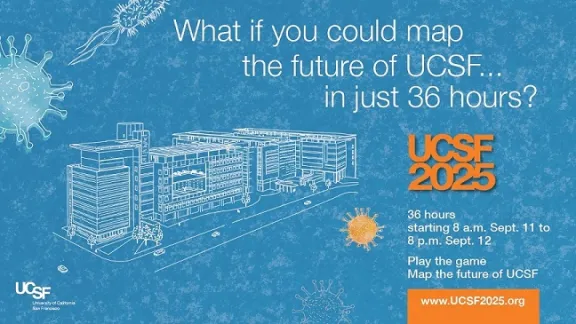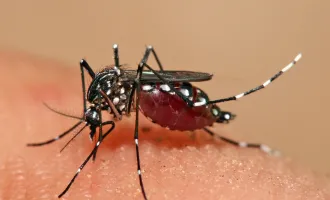
University Takes Bold Step into the Future with UCSF2025
Community Encouraged to Play Online Game on September 11 and 12
For 36 hours on September 11 and 12, members of the UC San Francisco community will have an opportunity to share their bold ideas to map the future of the University by participating in a novel online game.
The game – called UCSF2025 – seeks to engage faculty, staff, students, trainees and friends of UCSF to envision the University’s continued leadership in education, health and research through the next decade.
UCSF has partnered with the Institute for the Future (IFTF), http://www.iftf.org/home/ an independent, nonprofit research organization, to develop the game to spark innovative thinking across the University. While this is the first time that UCSF is taking this approach to gather input, other institutions have successfully used IFTF’s collaborative forecasting computing games to identify ideas from within to develop a strategy for moving forward.
Chancellor Susan Desmond-Hellmann, MD, MPH, and other campus leaders are encouraging all members of the UCSF community, and beyond, to share their ideas in UCSF2025 to help steer the direction of the nearly 150-year University.
“Your participation enables this effort to be an inclusive, grassroots, bottom-up effort — generating ideas from diverse perspectives,” Desmond-Hellmann said in an email to the campus community. “This is your opportunity to share your vision of UCSF’s future with me and the leadership team.”
Reinventing UCSF’s Leadership Role
The game is the official launch of UCSF2.0, a strategic process UCSF is embarking upon to develop a vision for the future and ensure UCSF’s continued excellence as a university exclusively focused on health. UCSF2.0 is intended to build upon and transcend existing and past strategic efforts, looking out 10 years into the future.
“The UCSF2025 game is the first step in a multiphase project identify several transformative ideas within the vision for the long-term future of the University,” said Jeff Bluestone, PhD, executive vice chancellor and provost. “We want everyone to participate and share their good ideas. The ideas, innovations, and themes that emerge from the game will inform a series of workshops across the university and ultimately help us create a visual map for UCSF — a map designed to serve as a resource of creative ideas in the coming decade.”
After the game, UCSF will work with key stakeholders from across the University to further define and refine the input into winning ideas for the future of UCSF.
Tapping the Wisdom Within UCSF
Players will begin the game by watching a provocative video to immerse themselves in a fictional, futuristic scenario of UCSF in the year 2025. They will have an opportunity to participate in challenges, posting short, twitter-length contributions of 140 characters or less. Game moderators from IFTF will highlight the boldest ideas that push the online discussion beyond the obvious or ordinary.
Players can earn points by building on other players’ ideas to create chains of innovation. Those players with the most points rise to the top of a leaderboard, which will be posted on a dashboard and blog for all to watch as the game unfolds over 36 hours through September 12.
To help rally excitement before the game and engagement during the two-days of playtime, approximately 100 ambassadors representing a cross-section of faculty, staff and students throughout campus and medical center are helping to spread the word to get their colleagues involved in shaping the University’s future.
Robert Wachter, MD, professor and associate chair of the Department of Medicine, is UCSF2025 ambassador who believes the game is a fun way to generate solutions to the big challenges facing UCSF
“UCSF, and other large institutions, are being rocked by enormous, rapid changes that challenge all of our bedrock processes and assumptions, including those involving Big Data, patient engagement, emerging science, and new health care policies,” Wachter said. “The organizations and individuals that will thrive in this dynamic, chaotic future will be ones that effectively engage their front-line workers in understanding these challenges and developing innovative solutions. The ones that don't — and many will be organizations that are highly successful today — will be ones that hunker down and resist transformative change.
“The UCSF 2025 project is an exciting, fun and dynamic way to engage the ‘wisdom of crowds,’” he said. “In our case, UCSF’s ‘crowd’ has proven itself time and time again to be very wise. Tapping this wisdom by taking advantage of new technologies and gaming techniques will help guarantee that we will take full advantage of the extraordinary opportunities that lie before us.”
Kristen Bibbins-Domingo, MD, PhD, an associate professor in the UCSF School of Medicine, is another ambassador who likes the gaming approach.
“We have great faculty, staff, and students at UCSF, but we also face significant challenges to building a thriving, sustainable UCSF of the future,” she said. “I like this approach because it engages all of us to help be part of the solutions.”
For longtime medical center administrator, Kathy Balestreri, executive director of Patient Care Services at UCSF Medical Center, the game gives all stakeholders who have a vested interest in UCSF a voice in its future.
“Although I may be retired in 10 to 15 years, UCSF has been a part of my family’s life since 1925, when my father was born here,” she said. “My mother and my husband retired from UCSF and now my son works here. I am and will always remain passionate about this great institution. To my friends and colleagues at UCSF, I say, ‘play the game for yourself, your family, your future – we all have a stake.”
More information can be found at ucsf2025.org.



